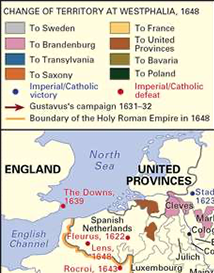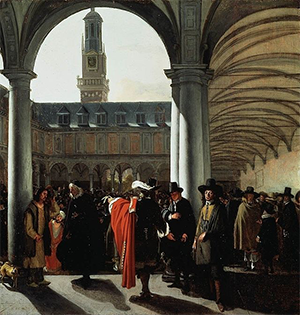The Dutch Republic
Part 3: The Golden Age and Modernism
Still the war was fought. By 1609, both sides realized that the borders were probably set: in the north were the Protestant Netherlands, and in the south were the Spanish (Catholic) Netherlands. By that time, Philip II had died and been replaced on the Spanish throne by his son, Philip III. Representatives of the two sides met at The Hague and hammered out a ceasefire, to last a decade and two years. This was the Twelve Years Truce. 
The two lands consolidated their holdings and looked outward for nearly a decade. In 1618 began the Thirty Years War, which involved all the major powers of Europe eventually. The Dutch got involved early on because Maurice of Orange's nephew was Frederick V, Elector of the Palatinate, whose assuming the throne of Bohemia and public proclamation of his Protestant faith made him an enemy of Catholic entities like the Holy Roman Empire. When the Twelve Years Truce expired, Spain and the Low Countries went back on the attack against each other. That struggle dragged on, as did the wider war. In 1625, Spanish forces captured the strategic city of Breda and Maurice of Orange died, leaving the Low Countries in need of a new leader. Frederick Henry, half-brother to Maurice, took up the mantle and had great success, forcing the thought-to-be impregnable fortress of 's-Hertogenbosch to surrender in 1629 and, in the March along the Meuse a few years later, capturing Maastricht and other major cities. 
At the same time, Dutch and Spanish ships were slugging it out on the high seas, economically and militarily. Dutch ships at times raided Spanish treasure fleets and had a go at conquering some Spanish possessions in the New World. (The ill-fated Dutch West India Company had a hand in this.) The Dutch had far more success in setting up and protecting their trade routes in the East. Spain powered up for one last large attack in 1639. A fleet of ships carried 20,000 troops to the Flanders area, intending to bring the northern resistance down. The Low Countries forces were ready and successful, triumphing at the Battle of the Downs. As it turned out, this was the last Spanish attempt to impose its will on the north. The Netherlands allied with France, and Spain looked for peace. The 1648 Treaty of Münster ended the war between the Netherlands and Spain, as part of the Peace of Westphalia. As a result, the Dutch Republic became an independent entity, and the Spanish Netherlands remained Catholic. Immigration to the Dutch Republic increased in the latter half of the 17th Century and continued into the following century. Many people from several neighboring countries settled in the Dutch urban centers, swelling the populations of those cities. No stranger to innovation, Dutch engineers dug a dedicated network of canals to connect those cities, not only for economic reasons but also for transportation means: On offer were towboats, to take people from city to city, on the water. All this time, the nominal head of the Dutch Republic was whoever was Stadtholder of the House of Orange. Such a position had seemed natural at the time of the Dutch Revolt, when William of Orange was the most powerful man around. His successors had kept the title and position, even though some other provinces had elected their own stadtholders and considered them their local head of government. From the first, however, predating the revolt, the Habsburg rulers of the Holy Roman Empire had recognized William as all but head of state, and so the tradition continued. At the same time, the provinces had their own representation in government, made up of the States General. The provinces sent representatives to this body, which advised the House of Orange Stadtholder and his retinue and also discussed various proposals before sending them back to the provinces for approval. As it happened, each province had one vote on matters of importance, and it took only one veto ("no" vote) to sink a proposal. Also in keeping with the egalitarian nature of the States General, the presidency of the body rotated through the provinces, with each one holding the reins of that functional yet symbolic office for a week before passing it on. As happened in other European countries, freedom of worship was one of the drivers that compelled the Dutch to seek out rule of their own territory. The northern provinces were predominantly Protestant and primarily Calvinist; people who practiced Catholicism also lived in those provinces. Once the Republic was in place, however, the government introducing a range of punishments for the practice of Catholicism. One thing that all provinces agreed on was the need for a common defense. The end of the Eighty Years War and the completion of the Peace of Westphalia left the Dutch Republic at peace for a time, but war soon found the Low Countries again. Four times in all, during two centuries, forces of the Dutch Republic and Great Britain (later the United Kingdom) went to war. The Dutch had the upper hand after the first three, all fought in the 17th Century. At the same time, King Louis XIV of France set his sights on the Spanish Netherlands. A violent struggle ensued, stopped for a time by the Treaty of Nijmegen in 1678. As a means of forging a new alliance, William III of Orange took advantage of his marriage (his wife, Mary, was the daughter of the ousted British King James II) and accepted the offer to serve as co-ruler of Great Britain. He led a bloodless invasion that his new subjects termed the Glorious Revolution. William took advantage of that alliance to fight alongside British troops in the War of the Spanish Succession, during the first quarter of the 18th Century. The war ended the way that the Dutch wanted it to, but the war had also drained the republic's coffers and much of the financial reserves. Things were so bad that the republic struggled for a time to pay interest on its national debt. A new French invasion mid-century convinced the provinces to give temporary overall authority to a new leader, William IV, a distant relative of the famed House of Orange leaders. At a stroke, the republic was more centralized than ever. With the threat of French occupation receding, the provinces again took up the call for autonomy. It was more severe than before, and an armed uprising ensued. William V, the Frisian successor to the fourth William, fled his seat of power and was rescued from imprisonment and possibly execution only by an incursion led by Frederick William II of Prussia, in 1787. Less than a decade later came the Batavian Rebellion. The result was a constitutional government, backed by Revolutionary France. Leading the government was a national assembly, dating to 1795. The chaos of the French Revolutionary Wars resulted in more heads of state, culminating in Louis Bonaparte (brother of the famous Napoleon) being named king in 1806. Thus ended the Dutch Republic. First page > The Prelude > Page 1, 2, 3 |
|
Social Studies for Kids
copyright 2002–2026
David White



 In the years before the war began, Antwerp (in what is today Belgium) was the leading economic center of the Low Countries. Spanish troops conquered the important city in 1585, and the Dutch Republic responded by closing off the River Scheldt, to prevent oceangoing ships from reaching Antwerp. In its place arose Amsterdam as a center of trade and economy. In the first decade of the new century came the Amsterdam Exchange (following the model of the Rotterdam bourse) and the Exchange Bank. Dutch trade, powered primarily by a very large merchant navy, brought large amounts of money into the republic's coffers, the result of trading in new and exotic materials like coffee, silk, sugar, and (above all) spices. Dutch banking became a model for other European countries to follow. Dutch influence spread far and wide–in economic circles and in cultural circles, as the Dutch Republic became known as a haven for art and culture. Painters such as Johannes Vermeer and Rembrandt van Rijn became household names. The 17th Century came to be known by many as the
In the years before the war began, Antwerp (in what is today Belgium) was the leading economic center of the Low Countries. Spanish troops conquered the important city in 1585, and the Dutch Republic responded by closing off the River Scheldt, to prevent oceangoing ships from reaching Antwerp. In its place arose Amsterdam as a center of trade and economy. In the first decade of the new century came the Amsterdam Exchange (following the model of the Rotterdam bourse) and the Exchange Bank. Dutch trade, powered primarily by a very large merchant navy, brought large amounts of money into the republic's coffers, the result of trading in new and exotic materials like coffee, silk, sugar, and (above all) spices. Dutch banking became a model for other European countries to follow. Dutch influence spread far and wide–in economic circles and in cultural circles, as the Dutch Republic became known as a haven for art and culture. Painters such as Johannes Vermeer and Rembrandt van Rijn became household names. The 17th Century came to be known by many as the 
